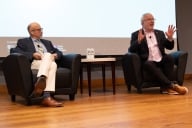You have /5 articles left.
Sign up for a free account or log in.
The average student pursuing a postsecondary credential completely online is a white, 33-year-old woman with a full-time job and a household income around $65,000 per year, according to a new survey sponsored by two companies involved in online consulting.
This woman is likely to be studying business -- the chosen field of 34 percent of students who are, recently were, or soon plan to be enrolled in fully online programs, according to the survey. Business administration and management, a popular avenue for students across all of academe, is far and away the most popular degree among the survey respondents, enrolling a greater percentage of fully online students than STEM fields, the social sciences, and the humanities combined.
“Schools simply cannot offer enough business programs if they want to attract large numbers of online students,” write the authors of the survey on behalf of its sponsors.
Carol Aslanian, senior vice president of market research services at Education Dynamics and a co-author of the study, said in an interview that she is not worried about flooding the supply side by recommending that every institution expand its online business offerings. "You don't tell a pharmacy to stop selling toothpaste just because every pharmacy is selling toothpaste," she said. But it will become increasingly important that institutions find a niche within the market to distinguish their business programs from the pack, she added.
The sponsors of the survey have skin in the game. One, Aslanian Market Research, which is part of Education Dynamics, provides consulting services to colleges formulating an online strategy; the other, Learning House Inc., helps colleges build online programs. The survey, carried out by a Denver-based research contractor, used a sample of 1,500 adults who are, recently were or plan soon to be enrolled in fully online programs. The margin of error was 3 percent.
The data offer insight into other trends, as well. As in most other areas of higher education, women dominate the market for fully online programs; 70 percent of respondents to the survey were women, and 60 percent were white. Just shy of 20 percent were black, and 8 percent identified themselves as Hispanic. A solid majority, 60 percent, were employed full-time; 20 percent had part-time jobs; and 19 percent were unemployed (with 12 percent actively looking for work).
The survey results affirm the demand for online pathways to non-degree credentials such as certificates and licenses. More than a quarter of the respondents said they were interested in a certificate or licensure program. In their take on the figures, the authors of the study -- Aslanian and David Clinefelter, chief academic officer at Learning House -- noted the buzz around “stackable” credentials and similar certificates designed to signal specific skills and aptitudes.
“As interest in competency-based learning rises, so will the demand for short-term, career-oriented, and compressed certificate study,” they write.
Another phenomenon to which the survey attests is the tendency of online learners, despite their desire to be able to learn outside the confines of time and space necessary to taking courses at the nearest college campus, to favor institutions that are located physically nearby. About 80 percent of respondents to the survey live within 100 miles of a physical presence of their preferred online program.
This figure includes not only traditional college campuses but also “service centers” for highly distributed institutions such as the University of Phoenix, which has 250 such centers nationwide. In any case, online students seem to place a high value on being able to drive to a physical plant if they want to, even if their courses are fully online.
When choosing an online institution, the respondents said they value reputation above all else, with price tag coming in a close second. And while respondents gravitated toward nonprofit institutions at a rate of 65 percent, for-profit institutions captured more than a third of the fully online market, with Phoenix alone registering a 15 percent share. “It is noteworthy,” the authors add, “that approximately 17 percent of respondents did not know what type of institution they attended.”
For the latest technology news and opinion from Inside Higher Ed, follow @IHEtech on Twitter.









